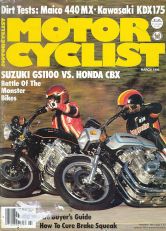
|

|

|
 |

|

|

|
 |
If there was ever an inevitable comparison test, this is it. Long before we'd ever even seen Suzuki's new 16-valve GS1100ET, calls and letters from readers began to come in with the same question: "is it faster than the Honda CBX?"
It was an unavoidable question. In 1978, when all four of the big Japanese companies unleashed their latest street-scorching superbikes, Honda was the last to join the fray. But their offering, the six-cylinder, twin-cam, 24-valve, 1047cc bullet called the CBX stunned even testers who had ridden the other three missiles. Although perhaps flawed in other areas, the CBX was unmatched for power, speed and acceleration. And in 1979, when the other three superbikes got slower, the CBX lost not an iota of its punch.
But for 1980, two things happened to threaten the CBX's crown. First, while making a series of changes and improvements to the CBX, Honda deliberately knocked back the Six's power a bit. Secondly, Suzuki released the four-cylinder, DOHC GS1100ET, the first bike to share the four- valve-per-cylinder layout which previously had been employed exclusively by Honda to extract power and performance from their four-strokes.
Suzuki let it be known that the GS1100 was intended to be the fastest, quickest street bike ever. Since any test of the GS1100 would inevitably draw comparisons with the CBX, we arranged a kind of Superbike Six-Day Trial to test the two machines side-by-side in every facet of performance demanded from big street bikes.
With the GS1100's engine howling and blue-white smoke billowing off the rear tire, Associate Editor and dragstrip tester Jeff Karr looked as though he'd been riding the bike for years. In fact, before throwing a leg over the Suzuki a few moments earlier, his only ride on the bike had been a quick trip down a driveway on the previous evening. His first real ride on the GS1100 began here at Orange County International Raceway's staging area where he was warming up the rear tire for maximum traction. Two other staffers rode the bikes to the stripe; now Jeff had to launch them down that all-important quarter-mile.
A slight headwind blew the rubber smoke away as Jeff released the front brake and lurched toward the starting line. A black tire track traced his path for the first 40 feet. At the line, he inched the bike forward until first one, then both of the staging lights winked on, indicating that the bike's front wheel was positioned exactly on the starting line. The Christmas tree's lights began to flash their countdown: yellow, yellow ... green. Jeff and the Suzuki were gone - the rear tire howling and smoking to indicate time lost. At the top of first gear Jeff was reminded of the drawbacks to learning about new bikes at the dragstrip; he couldn't find the shift lever on the first stab. More time lost. A moment later the clocks stopped at 12.02 seconds. Not very impressive, but it was a first pass. The speed reading told how it was going to be: 119.0 mph. Despite the slight headwind, that's 1.5 mph faster than the next quickest production line motorcycle (the 1978 CBX) Motorcyclist has ever blitzed through the dragstrip clocks.
On his next run, Jeff again smoked off the line, losing time as the rear wheel spun all the way through first gear, but still racked up an 11.7-second time and a speed of 119.5 mph. The Suzuki could have cracked 120 mph without the headwind. Searching for more traction, Jeff dropped rear tire pressure to 16 psi. His third run was the magic one: The clocks stopped at 11.339 seconds, a new record for Motorcyclist test bikes. The speed was 118.9 mph.
Jeff switched to the Honda and repeated the tire-heating and staging procedures. The CBX's clutch is easier to control than the GS1100's, but Jeff still came out of the hole with the rear tire burning. The Chrondeks stopped at 12.35 seconds and 114.6 mph. Not bad for a shake-down cruise. Jeff dropped rear tire pressure to 16 psi, and on its next dash through the quarter-mile, the Honda came out of the gate on the back wheel. Jeff didn't shut off, so the front wheel didn't kiss pavement until second gear. At the end of 440 yards, the clocks read 11.84 seconds and 116.1 mph. Jeff made two more tries, but the Honda was getting hot and wouldn't go any quicker or faster.
| PAGE: | Home | Tests | 1 | 2 | 3 | 4 | 5 | 6 | 7 | 8 | 9 | 10 | 11 |
|---|